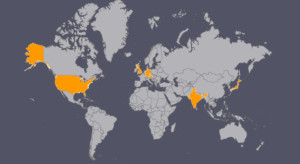And by: Kyle Kazanjian-Amory
Preliminary research done by: Devin Tang (Intern, GHJ)
Does anyone remember rewinding their VHS player to re-watch The Wizard of Oz for a third time? Maybe you were lucky enough to have one of those super-fast rewinder things. Here is a picture to jog your memory:
How easily we forget about the archaic technology that once ruled the world of media. Now all it takes is a few clicks and you’re staring at Kevin Spacey for 10 hours straight, binge watching House of Cards. And to think kids used to have to play outside on the weekends! Bob Dylan said it best, “The Times They are a Changin’.”
Netflix has played a crucial role in the transformation of media production and consumption over the past 20 years. Netflix began as a DVD by mail service business in 1997, competing with the now urban legend, Blockbuster. Ironically, in 2000, Blockbuster rejected several offers to purchase Netflix for around $50 million. Jokes on them!! Ten years later, in September of 2010, Blockbuster declared bankruptcy. Conversely, Netflix now has a Market Cap just shy of $40 billion and have transformed into the largest Subscription Video-On-Demand (SVOD) service in the world. Just this year, in January, Netflix announced the expansion of their service offerings to an additional 130 countries.
Despite Netflix’s success in expanding globally, the company’s most recent earnings report was underwhelming and raised questions over the company’s opportunities for continued growth. Investors and analysts are worried that the market is becoming saturated. Yes Netflix has experienced incredible growth (over 2,400 percent in the last 10 years), but can Netflix continue to grow with competitors such as Hulu and Amazon eagerly trying to secure their piece of the pie? A recent price increase of two dollars for Netflix’s services from $7.99 to $9.99 sent some customers packing. Apparently skipping out on guacamole at Chipotle once or twice a month wasn’t worth keeping a Netflix subscription. The customer’s sensitivity to pricing was a bit of a wakeup call for Netflix, who will have to reexamine their pricing strategy in the U.S. and internationally. At the very least, they didn’t increase the subscription fee by 60 percent, and launch Quixster again, so at least they have learned something since 2011.
Netflix has been expanding at an incredible rate, dominating the race to become a global streaming platform. To put things in perspective, here is a map of the territories where Netflix streaming services are currently available:

Here is a map of where Amazon’s instant video streaming services are currently available:

Finally, Netflix’s other main competitor, Hulu, does not require a map as it is only available in the U.S. and Japan.
China, the largest potential market by population, provides the biggest challenges as it is the only major market that Netflix has been unable to break into. The financial benefit of entering the Chinese marketplace would be massive, and Netflix is still exploring this possibility. However, the barrier to entry is large, and Netflix will need to work with the Chinese government to formulate a deal so they can offer their services. It is not clear if Netflix will be able to accomplish this feat any time soon. In the meantime, Netflix will continue to focus on growth within its existing international markets.
Netflix has been licensing programming from Latin America into the US and has recorded incredible viewing numbers. Tapping into new demographics of users in the US will help Netflix to further expand its dominance in the industry. By focusing on understanding its user base and expanding its international brand and content, Netflix can appeal to an even larger audience. For example, in an attempt to expand its existing Spanish Speaking user base, Netflix launched its own original Spanish language show Club of Cuervos. Netflix is making an attempt to break through the cultural barriers and appeal to the global community.
Finally, on the business side of things, SVOD services like Netflix, Hulu and Amazon have been providing a consistent and healthy income source for studios with high value licensing deals. The licensing deals have helped to make up for the declining theatrical and home video market that have been troubling the major studios. Netflix has played a highly disruptive role within the entertainment world as it is constantly evolving to keep up technological and consumer preferences. Where Netflix goes from here, only time will tell.

